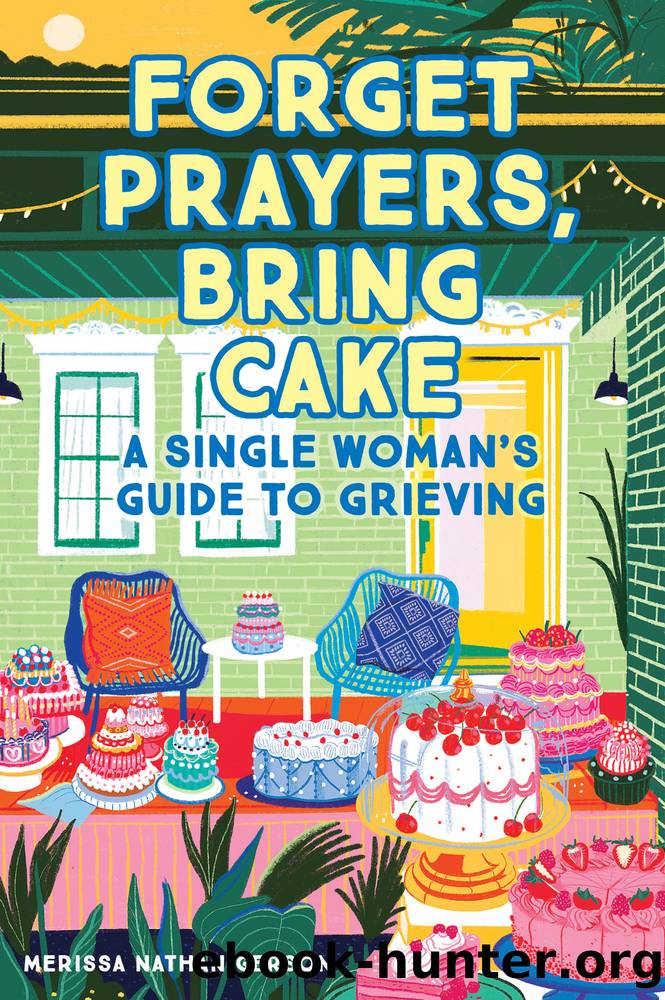Forget Prayers, Bring Cake by Merissa Nathan Gerson

Author:Merissa Nathan Gerson
Language: eng
Format: epub
Publisher: Mandala Publishing
Published: 2023-01-03T00:00:00+00:00
UNDERSTANDING TRAUMA
Why do these clinical terms matter? They help explain a myriad of things we go through in witnessing death, in experiencing loss, in amassing symptoms over time. These terms donât need to be clinically DSM-slapped on to you to be useful. They are guideposts; they are signs; they explain the emotional and physical terrain of these fraught and horrifying times. And they explain why all the practices you have learned thus far work: They calm the parasympathetic nervous system; they settle you down from the panicked buzz you enacted to protect yourself from a threat that is no longer there. Or, for many, is. These terms may or may not apply to you, may or may not explain your symptoms, may or may not be tossed your way by a health professional. Death is easy for some, wretched for others, with a full spectrum in between. It helps, however, to know this language, to be equipped with this knowledge, to begin to have the tools to recognize when âtoo muchâ has arrived.
What is shock? Shock shows up in all kinds of ways. Leaving your body, so to speak, staring blankly, or being unable to compute what is right in front of you. Shock will take you away from the present moment. Think of a kid who falls, gasps, stares about, and a few moments later, screams. The shock is that pause. It protects you when processing a horror that is just too much at that very moment.
What is it to âfreezeâ? Like a deer caught in the headlights, freeze is an acute âstop, look, and listenâ mechanismâanimalisticâthat allows a body to assess a threat. Do you feel shame for being helpless, inactive in a vital stressful moment? You may have in fact been assessing the very best and wisest option in that pause. Stillness can be a high state of being alert, or a simple catatonic moment of fear. It can also function as dissociation from a moment that is too intense for our nervous systems to calibrate.
What is âfight or flightâ? This is a built-in mechanism that helps the body assess whether to run or to rage when confronting a threatening entity. Think animals battling in the wild. âFight or flightâ commonly refers to the activities of your sympathetic nervous system, which toggles like a light switch with your parasympathetic nervous system (which controls ârest and digestâ functions). This is an adaptation of the stress response to a mortal threat, and it triggers a flood of physiological reactions that equip you for battle or retreat. When it is triggered unnecessarily or will not subside, issues can arise in the nervous system.
What is fainting? Fainting is a freeze symptom. Physically, it is a mechanism of the vasovagal syncope response, which can also induce vomiting and loss of bowel control. Think survival mechanisms. Think of your body as that of an animal. What is happening? The body is rejecting something horrific, toxic, repulsiveâanything overwhelming or threatening that the system canât metabolize.
Download
This site does not store any files on its server. We only index and link to content provided by other sites. Please contact the content providers to delete copyright contents if any and email us, we'll remove relevant links or contents immediately.
| Codependency | Conflict Management |
| Dating | Divorce |
| Friendship | Interpersonal Relations |
| Love & Loss | Love & Romance |
| Marriage | Mate Seeking |
Doing It: Let's Talk About Sex... by Hannah Witton(8563)
The 5 Love Languages: The Secret to Love That Lasts by Gary Chapman(8528)
Should I Stay or Should I Go? by Ramani Durvasula(6799)
The Road Less Traveled by M. Scott Peck(6649)
The Lost Art of Listening by Michael P. Nichols(6484)
Daring Greatly by Brene Brown(5652)
We Need to Talk by Celeste Headlee(4881)
Beartown by Fredrik Backman(4435)
Men In Love by Nancy Friday(4342)
The State of Affairs by Esther Perel(3944)
The Rules Do Not Apply by Ariel Levy(3914)
How To Win Friends and Influence People by Dale Carnegie(3780)
Reflections Of A Man by Mr. Amari Soul(3708)
The Ethical Slut by Janet W. Hardy(3512)
Algedonic by r.h. Sin(3508)
Pillow Thoughts by Courtney Peppernell(3414)
Finding My Forever by Heidi McLaughlin(3313)
He's Just Not That Into You by Greg Behrendt & Liz Tuccillo(3311)
I Love You But I Don't Trust You by Mira Kirshenbaum(3235)
